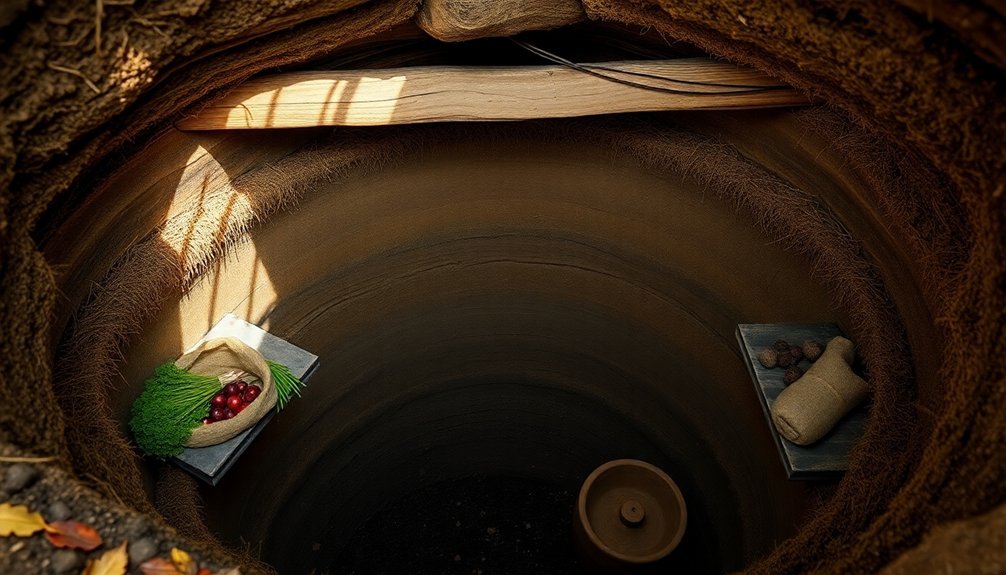You'll find three proven earth pit methods to preserve food without electricity: root cellars, backyard clamps, and stream-side cooling systems. Root cellars use natural hill insulation and dual ventilation to maintain ideal temperatures. Backyard clamps involve layering produce between straw and earth, with multiple small clamps offering better preservation when accessing stored items. Stream-side cooling systems leverage flowing water and shaded bank areas to create natural refrigeration zones. Each method requires specific setup considerations for temperature, moisture control, and pest prevention – essential details that'll help you choose the right preservation technique for your situation.
Indigenous Root Cellar Design

Anyone looking to build a traditional root cellar should first consider its location and basic design elements.
You'll want to find a hill or knoll that provides natural insulation, making sure it's easily accessible but away from heat sources like chimneys. For most families, a 4×6 feet space will suffice, especially when you're integrating it into an existing basement or garage area.
When constructing your cellar, you'll need to focus on proper insulation and ventilation. Maintaining 35-40 degrees Fahrenheit is crucial for optimal food preservation.
Traditional methods include using straw bales, sawdust, or earth and clay as natural insulators. You can enhance this with modern materials like mineral wool batts or extruded polystyrene foam between wall studs.
Install two vents – one near the ceiling and another at ground level – to create effective air circulation that removes excess moisture and harmful gases.
For the structure itself, you can use logs for the roof with a hatch opening to minimize cold air entry.
Add an insulated steel door with weather stripping to maintain consistent internal conditions.
If you're building in challenging environments, consider using earthbag construction techniques, which have proven effective in various climates.
Backyard Clamp Storage Systems
Simplicity defines backyard clamp storage systems, a time-tested method for preserving root vegetables through winter months.
You'll find two main approaches: the traditional earth clamp and the modified container method. Each offers unique advantages for your food preservation needs.
In the traditional method, you'll need to dig a trench twice the size of your vegetables. Layer straw at the bottom, arrange your produce, and add more straw before covering with earth. Leaf bags can provide a simplified alternative to traditional straw layering.
It's best to create multiple small clamps rather than one large one, as this helps maintain insulation once you've opened them.
If you're looking for a less labor-intensive option, try the modified container method. You can use plastic pails or trash cans with drainage holes, buried in the ground and filled with your root crops.
Don't forget to add straw or sand for insulation. This approach requires less digging while still leveraging the earth's natural cooling properties.
For both methods, you'll want to protect against moisture and pests. Add hardware cloth to deter rodents, and consider using a tarp for additional weather protection.
Remember to choose a location that's cool, dark, and sheltered from direct sunlight.
Stream-Side Earth Cooling Methods

Ancient cultures discovered the remarkable cooling power of flowing water, and you can harness this natural refrigeration system today. By combining stream-side locations with earth pit storage, you'll create an effective cooling system that doesn't require electricity or modern technology.
To create a stream-side earth cooling pit, you'll need to dig a shallow hole near a stream bank, ideally in a shaded area where the ground stays naturally cool. Similar to cellaring techniques, this method provides ideal conditions for storing root vegetables and fermented foods. You can enhance the cooling effect by positioning your storage container where it can benefit from both the stream's water flow and the earth's natural insulation.
Make sure you're using waterproof, secure containers to protect your food from moisture and potential flooding.
If you don't have direct access to running water, you can still utilize underground cooling by digging your pit near areas with high groundwater levels. The earth's natural thermal properties will help maintain consistent cool temperatures.
Position your containers so they're partially buried, allowing for easy access while maintaining proper cooling. This method works particularly well for preserving perishables like dairy products, meat, and foraged vegetables, giving you a reliable food storage solution that's both practical and sustainable.
Frequently Asked Questions
How Long Can Dried Foods Remain Edible When Stored in Traditional Earth Pits?
You'll find your dried foods can last 6-12 months in cool earth pits. Your fruits stay fresh up to 1 year at 60°F, while vegetables last half that time. Your herbs remain good for 1-3 years.
What Indigenous Methods Were Used to Detect Spoilage in Underground Storage?
You'd rely on visual checks for mold, smell tests for rotting, and physical inspection of containers for damage. Traditional knowledge passed down taught you to spot discoloration, unusual textures, and off-putting odors.
Can Modern Plastic Containers Replace Traditional Bark Barrels in Pit Storage?
You can replace bark barrels with plastic containers, but you'll need to carefully manage ventilation and moisture. Consider using both methods together to combine plastic's durability with bark's natural insulation benefits.
How Deep Should Storage Pits Be Dug in Different Climate Zones?
You'll need to dig 1-2m deep in hot climates for vegetables, 3.5-5m for grain storage, and below the frost line in cool regions. Match your depth to local water tables and drainage conditions.
Which Foods Are Unsafe to Store Using Earth Pit Preservation Methods?
You shouldn't store high-risk foods like raw meat, dairy, eggs, seafood, or prepared salads in earth pits. Also avoid foods needing strict temperature control, including cooked rice, pasta, and opened canned goods.
In Summary
These three traditional earth pit methods show you're never far from having a natural refrigeration system. Whether you're exploring indigenous root cellars, building a backyard clamp, or utilizing stream-side cooling, you'll find these time-tested techniques both practical and sustainable. You've now got the knowledge to preserve food without electricity, just as our ancestors did for thousands of years.





Leave a Reply